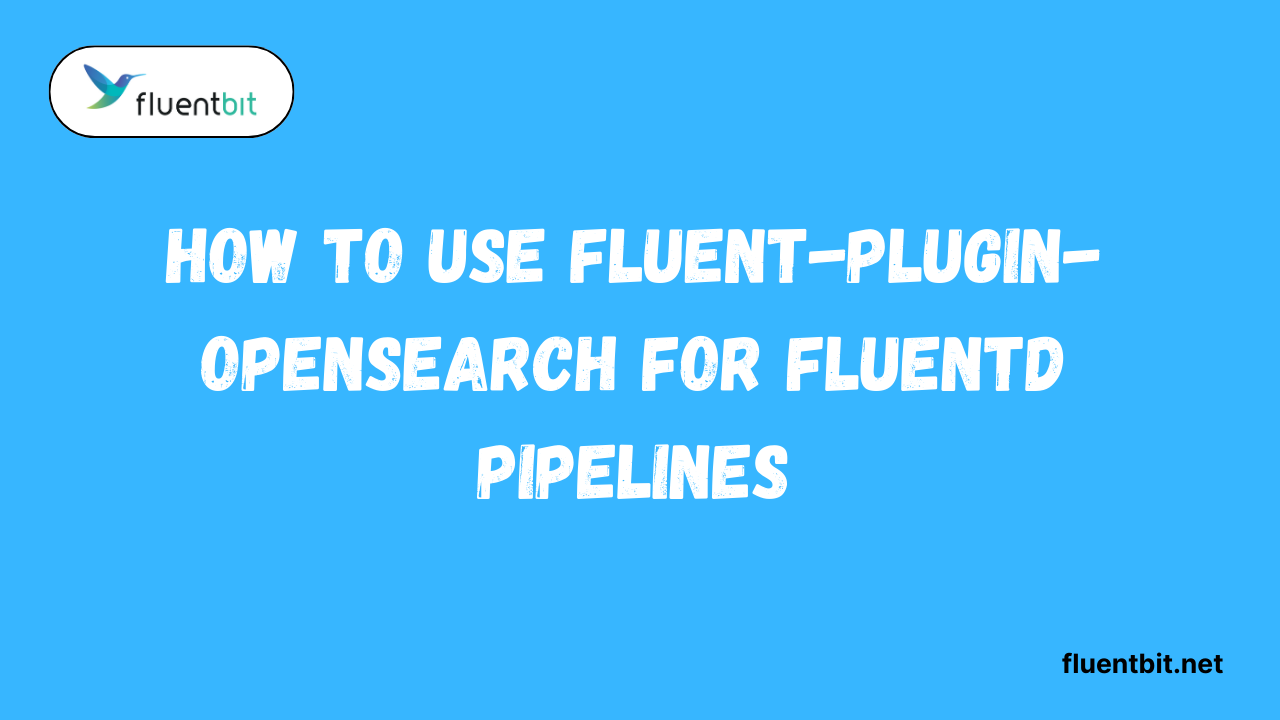Table of Contents
ToggleIntroduction
If you’re diving into log management, Fluent Bit and Fluentd Pipelines are absolute game-changers. Pairing them with OpenSearch makes handling large volumes of logs smooth and efficient. With Fluentbit Elasticsearch, you can collect processes and store logs without losing performance, making your pipeline reliable and easy to scale.
Overview of Fluentd and OpenSearch
If you’re diving into log management, Fluent Bit and its ecosystem are absolute lifesavers. Fluentd serves as the heart of your logging pipeline, collecting, processing, and forwarding logs from various sources.
Importance of Efficient Log Pipelines
Efficient log pipelines save both time and headaches. By optimizing your Fluent Bit output to Elasticsearch, logs flow smoothly from applications to storage without bottlenecks. This is crucial for high-traffic environments where delays could mean missing critical insights.
What is fluent-plugin-opensearch?
The fluent-plugin-opensearch is essentially a bridge between Fluent Bit or Fluentd and your OpenSearch cluster. It takes care of formatting, indexing, and pushing logs efficiently so you don’t have to manually manage the flow. With Fluent Bit Elasticsearch output this plugin ensures that logs are delivered reliably even during high-load periods.
Core Functionality and Purpose
At its core, fluent-plugin-opensearch formats incoming log data and sends it to OpenSearch indices efficiently. This ensures that your log data is structured, searchable, and stored in a way that supports fast querying. Using this plugin with Fluent Bit enables you to control how data flows apply filters and manage buffer sizes for seamless ingestion.
Key Benefits for Logging Pipelines
The most significant advantage of fluent-plugin-opensearch is reliability. It ensures that logs reach OpenSearch safely even in the event of network hiccups or bursts of traffic. This is where Fluent Bit shines allowing you to tune Fluent Bit output to Elasticsearch for optimal performance.
Additionally the plugin helps maintain searchable structured logs which are vital for monitoring alerting and troubleshooting.
Installing and Configuring fluent-plugin-opensearch
Getting started with fluent-plugin-opensearch is easier than you might think! First, ensure your system has Fluent Bit or Fluentd already set up. Then, install the plugin using a simple command, which integrates seamlessly with your logging pipelines. With this plugin, your logs can flow directly to OpenSearch without any hassle, making it a perfect companion to Fluentbit Elasticsearch setups.
Prerequisites and System Requirements
Before proceeding, ensure that your system has Fluentd installed and running smoothly. You’ll also need Ruby installed since fluent-plugin-opensearch is a Ruby gem. Having a running OpenSearch cluster is crucial, and checking your network access between Fluentd and OpenSearch saves headaches later. Knowing your fluent bit Elasticsearch output requirements ahead of time helps too.
Step-by-Step Installation Guide
Installing the plugin is surprisingly simple. First, use the’ gem’ command: ‘ gem install fluent-plugin-opensearch’. This adds the plugin to your Fluentd environment, making it ready for configuration. Next, verify that the plugin is installed correctly using the fluent-gem list command.
At this point, you can start integrating it into your logging pipelines.
Basic Configuration Settings
- Set up general solver parameters like time step, convergence criteria, and simulation duration.
- Define material properties, boundary conditions, and initial conditions for the model.
- Configure mesh options, including element type and density, for accurate results.
- Enable logging and monitoring to track solver performance during runs.
- Save configuration templates for reuse in similar projects to save time.
If you’re new to deployment, our walkthrough on Fluent Bit on Ubuntu setup is a great companion piece before installing any plugins.
Integrating fluent-plugin-opensearch into Fluentd Pipelines
Adding fluent-plugin-opensearch to your existing Fluentd pipelines is a breeze! Start by including the plugin in your pipeline configuration under the output section. This allows logs from multiple sources to flow directly into OpenSearch complementing setups that use Fluentd with Elasticsearch.
With this integration you get seamless log management and real-time search capabilities without any effort.
Adding the Plugin to Existing Pipelines
If you already have Fluentd pipelines in place, integrating the plugin is straightforward. Just insert the OpenSearch output section into your pipeline configuration, and Fluentd will start sending logs to your cluster.
Using Fluentbit Elasticsearch alongside Fluent Bit output Elasticsearch ensures the plugin respects your pipeline structure and preserves log formatting.
Configuring Input, Filter, and Output Sections
For optimal results, configure input sources to capture the correct logs, apply filters for transformations, and then route them through the OpenSearch output plugin. This lets you manipulate and enrich logs before storage.
With Fluentbit Elasticsearch output you can fine-tune buffer sizes and chunk sizes to match the throughput of your system.
Ensuring Data Consistency and Reliability
Data consistency is key in logging pipelines. Ensure that retry settings and buffer configurations in Fluent Bit are correctly tuned. This keeps Fluent Bit Elasticsearch pipelines reliable, even under heavy load. By combining Fluent Bit output with Elasticsearch and careful buffer management you can avoid bottlenecks and data loss.
Advanced Configuration Options
When it comes to Fluent-plugin-opensearch, exploring advanced settings can take your pipelines to the next level. Properly configuring index management and rollover ensures that your logs remain organized, searchable, and don’t overwhelm your storage.
This is especially useful when using Fluentbit Elasticsearch setups with high-volume logging environments.
Index Management and Rollover Settings
Managing your OpenSearch indexes efficiently is crucial to maintaining organized logs. With fluent-plugin-opensearch, you can set up automatic index rollovers based on size age or document count. This works in conjunction with Fluentbit Elasticsearch output ensuring that your log data remains structured and searchable without manual intervention.
Authentication and Security Configurations
Security is non-negotiable when sending logs to OpenSearch. The fluent-plugin-opensearch plugin supports various authentication methods including basic credentials API keys and even TLS/SSL for encrypted connections.
This setup works perfectly with Fluentbit Elasticsearch pipelines, giving you confidence that your log data is protected in transit.
Optimizing Performance for Large Datasets
- Use adaptive meshing to focus resources on critical areas and reduce unnecessary calculations.
- Adjust solver settings like time step, iteration limits, and convergence criteria for efficiency.
- Enable parallel processing or multi-threading to speed up simulations.
- Optimize data storage and output frequency to manage large volumes of results.
Monitoring and Troubleshooting
Keeping an eye on your Fluent Bit pipelines is crucial for smooth operations. Start by checking the plugin logs and metrics regularly to catch anomalies early. The fluent-plugin-opensearch plugin provides detailed logs which when combined with fluentbit elasticsearch output, help you pinpoint bottlenecks and slow queries quickly.
Checking Plugin Logs and Metrics
Plugin logs are your first line of insight into how data is flowing. With fluent-plugin-opensearch, you can view each successful write retry and error making troubleshooting a breeze. Cross-referencing these logs with Fluent Bit Elasticsearch output settings ensures you can fine-tune your pipeline without guesswork. Metrics like throughput, queue size, and error counts are invaluable.
Common Issues and Fixes
Even the best pipelines hit bumps occasionally. Common issues include connection timeouts, authentication errors or log loss during spikes in network activity. Using fluent-plugin-opensearch alongside fluentbit output elasticsearch makes troubleshooting predictable and structured.
Fixes often involve adjusting the Fluent Bit chunk size, increasing buffer capacity, or tuning retry settings.
Ensuring Pipeline Stability Over Time
Long-term stability requires a mix of monitoring tuning and maintenance. Schedule regular checks of the Fluent Bit buffer size Fluent Bit chunk size and plugin health to catch issues before they escalate. With fluent-plugin-opensearch integrated you gain real-time visibility into your log streams, ensuring a healthy pipeline.
A must-read here is Running Fluent Bit in Kubernetes, which highlights common pitfalls and fixes when scaling pipelines.
Best Practices for Using fluent-plugin-opensearch
To get the most out of fluent-plugin-opensearch, follow a few innovative practices. Start by designing your indices for performance use time-based indices or categorized naming to optimize query speed. Combining this with Fluent Bit Elasticsearch output ensures that logs are stored efficiently and remain easily retrievable.
Structuring Indices for Performance
Organizing indices properly is essential for both search speed and storage efficiency. Time-based indices are well-suited for logs that grow rapidly, while categorized indices are beneficial for filtering by source or type.
This approach works seamlessly with Fluent Bit output to Elasticsearch, ensuring queries are fast and reliable. Additionally, avoid overly large indices, as they can slow down searches and increase memory usage.
Using Buffer and Chunk Size Effectively
Optimizing Fluent Bit’s chunk size and buffer size is a game-changer for pipeline stability. Small chunks reduce memory pressure but may increase write operations, while larger buffers can handle bursts without losing logs. Finding the right balance is key to maintaining smooth Fluent Bit operations.
Scaling Fluentd Pipelines Efficiently
When log volume grows, scaling your Fluentd pipelines becomes crucial. Use multiple threads or distributed pipelines, and adjust the Fluent Bit buffer size and chunk size accordingly. This ensures that even large-scale deployments handle data without hiccups.
Integrating fluent-plugin-opensearch in a scalable setup also means leveraging retries, proper indexing, and load balancing.
Conclusion
Mastering fluent-plugin-opensearch is all about smart configuration, tuning, and scaling. Structuring indices monitoring Fluent Bit buffer size, and adjusting Fluent Bit chunk size help keep your pipelines reliable and performant. By following these best practices your Fluent Bit pipelines stay efficient, resilient and ready to handle any volume of logs.
FAQs
What is fluent-plugin-opensearch?
It’s a Fluentd plugin that sends logs to OpenSearch or Elasticsearch clusters efficiently. It supports bulk indexing, buffering, and advanced configuration for smooth log pipelines. Using it with Fluent Bit ensures reliable log forwarding.
How do I configure fluent-plugin-opensearch for Fluentd?
Install the plugin, define your OpenSearch endpoint, and set authentication details. Tuning the Fluent Bit buffer size and chunk size helps prevent dropped logs and maintains smooth performance.
Can fluent-plugin-opensearch handle large volumes of logs?
Yes! By adjusting fluent bit chunk size and fluent bit buffer size, you can efficiently process high-volume log streams without bottlenecks.
What’s the difference between fluent-bit Elasticsearch output and fluent-plugin-opensearch?
Both send logs to search engines, but the plugin is specific to Fluentd pipelines, while Fluent Bit Elasticsearch output is optimized for Fluent Bit. Each has unique tuning options for buffer and chunk sizes.
How do I secure logs sent through fluent-plugin-opensearch?
Enable SSL/TLS, use authentication tokens, and configure user permissions. These settings protect data in transit and prevent unauthorized access to it.
What are common performance tuning tips?
Use an optimized Fluent Bit buffer size and Fluent Bit chunk size, structure indices properly, and monitor pipeline metrics. This ensures stable performance under heavy loads.
Latest post:
- Best Practices for Fluent Bit Output Matching in Complex Pipelines
- Setting Up Fluent Bit with Open Telemetry for Unified Observability
- Fluent Bit vs Fluentd: Choosing the Right Tool for OpenSearch Logging
- How to Use fluent-plugin-opensearch for Fluentd Pipelines
- Is Ansys Fluent Better for Complex Fluid Flow Simulations?












